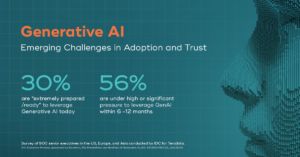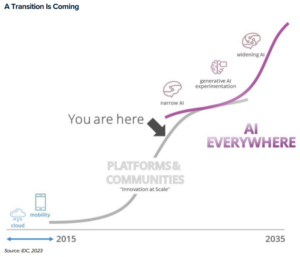
Cutting Through the GenAI Noise

(Berit Kessler/Shutterstock)
The launch of ChatGPT in late 2022 ignited an explosion of interest in generative AI technology, as well as a hefty dose of hype and uncertainty. For businesses starting to plot their GenAI strategies, cutting through the hoopla and figuring out how it fits into their operations is a priority.
There’s no shortage of awareness of GenAI at the moment. “In the last six to seven months…every meeting that I’ve had with a customer always ends up going towards generative AI,” Databricks CEO Ali Ghodsi said during the recent Data + AI Summit. “Every conversation, even when it’s about something else, at the end of the day, it goes towards generative AI.”
Data from IDC backs up Ghodsi’s claim. An IDC survey sponsored by Teradata released yesterday found that nearly 80% of executives are confident that their companies will leverage GenAI in future offerings or operations.
“No other technology has achieved what GenAI has done in less than a year–sparked the imagination of millions, disrupted the way humans create content, and fundamentally changed the way people think and work,” wrote IDC analysts Chandana Gopal and Dan Vesset in the preview of the survey, which you can read here.
However, there is a significant gap between companies’ desire to leverage GenAI and their actual capability to do so. The same IDC survey of 900 global executives found that only 30% of survey respondents are well prepared to leverage GenAI today, a figure that execs expect to increase moderately to 42% over the next six to 12 months.
Companies are in the middle of a massive race to adopt GenAI and to realize the business benefits before their competitors do. The IDC survey shows that 56% of execs are under “high” or “significant” pressure to get GenAI rolled out over the next six to 12 months.
That begs the question: How exactly can companies adopt GenAI?
“Everybody at this point this year is like, what’s possible now? How should I be evaluating this?” said Pete Erickson, the organizer of the VOICE + AI conference taking place in Washington, D.C. next month. “This is a very unique year. And in a few years, things will normalize more and there will be really set outcomes for people.”
The GenAI path for contact centers, which for years have been investing in advanced natural language processing (NLP) and large language models (LLMs), is fairly clear at the moment (see “How Generative AI Is Transforming the Call Center Market” for more info on that topic).
But how will other industries adopt GenAI?
One of the biggest questions companies must resolve is whether they should build their own GenAI or whether they should buy somebody else’s. Companies can use APIs to tap into very powerful pre-built AI models, such as OpenAI’s GPT-4, which was trained on a huge corpus of data (basically the entire Internet) and can generate text as well as images.
But many companies are loathe to take the API approach for fear of losing control of their data. They also see massive models like GPT-4 or Google’s PaLM, which are trained to be conversant in many topics, as overkill for their particular needs.
“This is the number one question that’s coming up everywhere,” Databricks’ Ghodsi says. “There’s a lot of companies and services out there where they give you generative AI but they don’t give you your own model, so you don’t control your own IP.”
However, developing your own large language model, the heart of GenAI, is expensive and time-consuming. Training OpenAI’s GPT-3 was estimated to cost about $4.6 million on Nvidia Tesla V100s. The shortage of GPUs is another factor, as is the technical skill required to train an LLM.
That’s what drove Ghodsi to acquire MosaicML, a generative AI startup co-founded in early 2021 by Naveen Rao. Under Databricks wing, MosaicML will become a sort of “factory” for churning out custom GenAI models for customers. The models will be much smaller than things like GPT-4 and cost a fraction of the price.
Beyond the buy vs. build debate, there is the question of what companies can do with GenAI. According to IDC’s Group VP Philip Carter, there will be three broad use cases for GenAI, including productivity apps, business functions, and industry-specific use cases.
Productivity applications of GenAI will cover basic use cases, such as summarizing a report, generating a job description, or generating Java code. “This functionality is being infused into existing applications (E.g. Co-Pilot for Microsoft, or Duet AI for Google),” Carter writes in a recent blog.
Business function GenAI applications will be a little more targeted towards specific outcomes, such as assisting with marketing, sales, or procurement, according to Carter. These will involve the adoption of one or more GenAI models. “Many organizations are testing these types of use cases but are concerned about IP leakage and data governance,” he writes.
Lastly, some companies will go all-in and create their own industry-specific GenAI applications, such as for drug discovery or material design in manufacturing, Carter writes. These customized models will require the most work, and in some cases will involve companies building their own GenAI models (although others will undoubtedly access existing models via APIs), the analyst writes.
But there’s a lot of other work to do before companies can start leveraging their own data to create Gen AI apps, whether they buy access to an existing one or build their own. For instance, issues of governance and transparency are rapidly coming to the forefront. The Association of Computing Machinery recently issued a new paper calling for more regulations of high-risk AI apps, with one author calling the current situation “the Wild West.”
Companies should also be investing in building an intelligent architecture to manage the lifecycle of their data and models, according to IDC’s Carter. “This should also include protocols around data privacy, security, intellectual property (IP) protection,” he wrote.
The future of GenAI is bright, as it is for artificial intelligence in general. Even if the current buzz around things like ChatGPT inevitably begins to fade (as it appears to be doing), every new technology is stepping stone to the next technology, which will be even more powerful than what preceded it.
With that in mind, the possibilities around AI are truly awe-inspiring, and businesses would be well-served to prepare themselves for today’s GenAI, as well as whatever AI serves up next.
Related Items:
Regs Needed for High-Risk AI, ACM Says–‘It’s the Wild West’
How Generative AI Is Transforming the Call Center Market
What Is MosaicML, and Why Is Databricks Buying It For $1.3B?


































